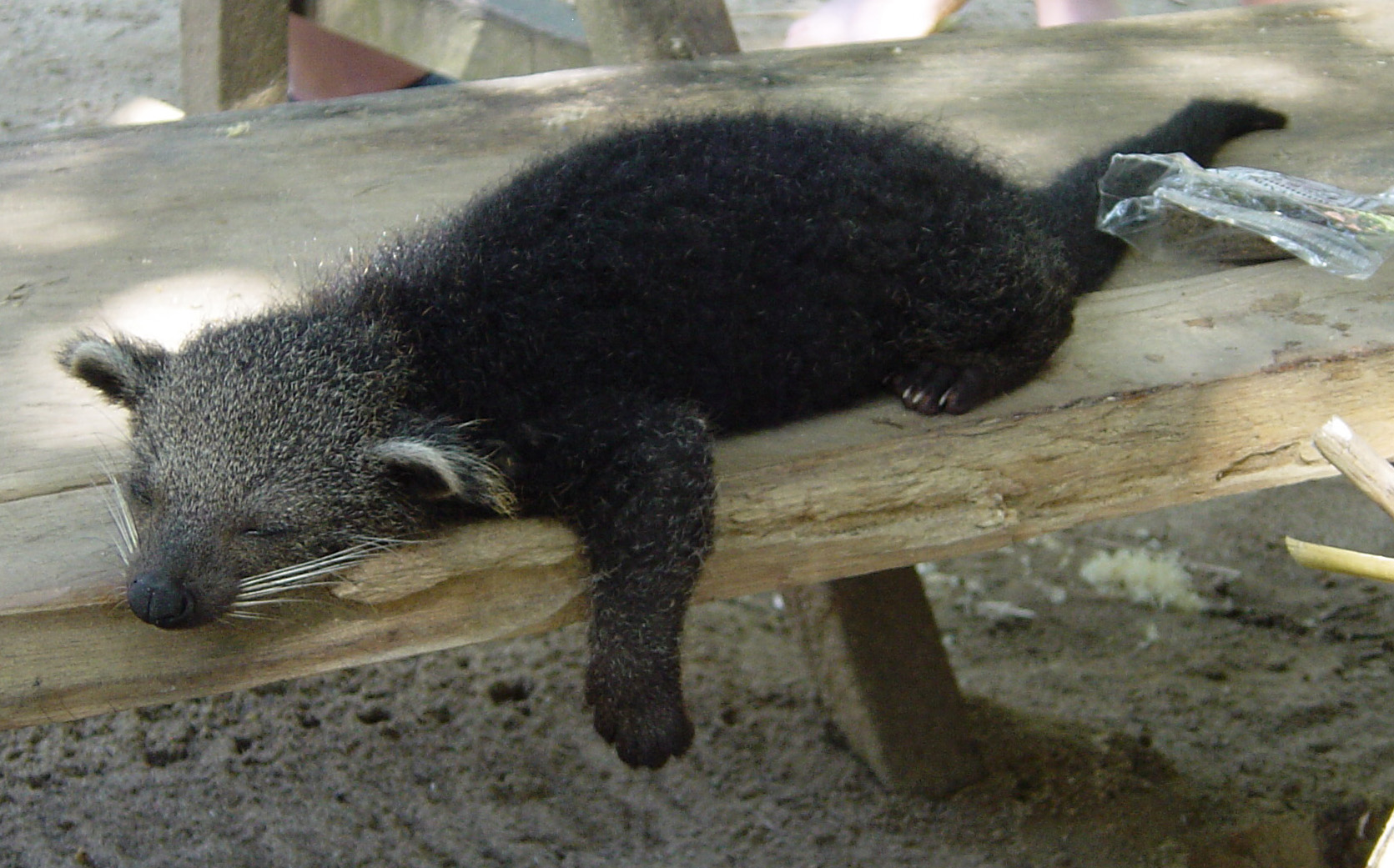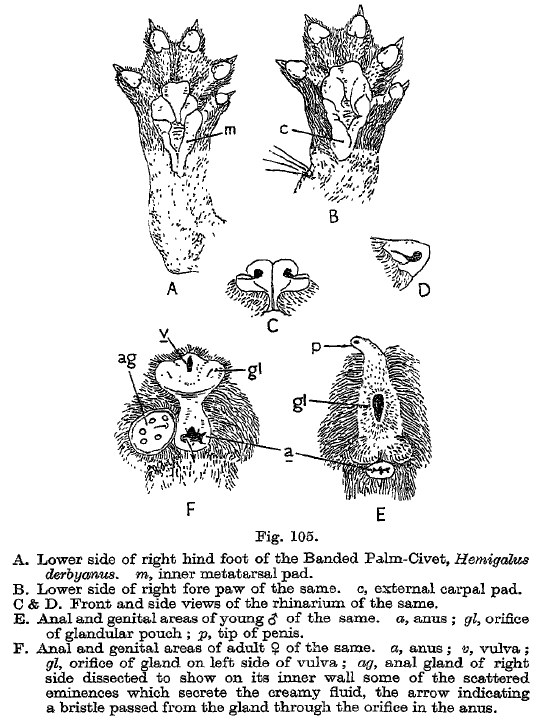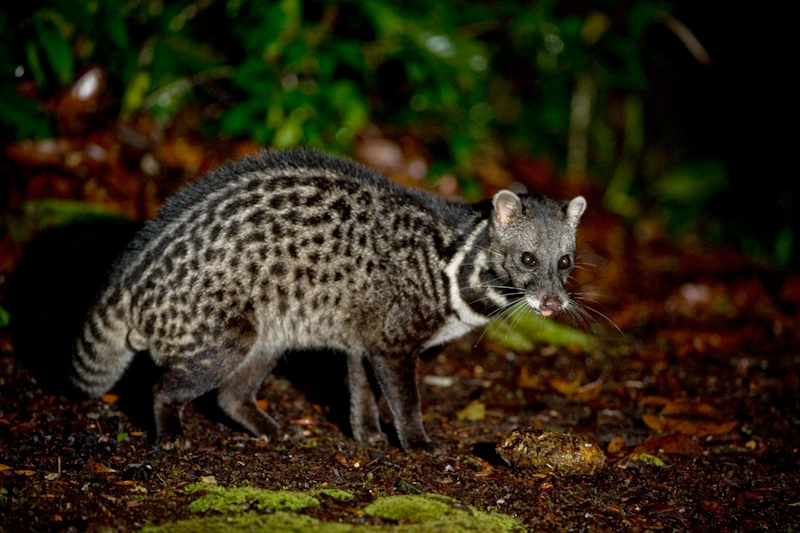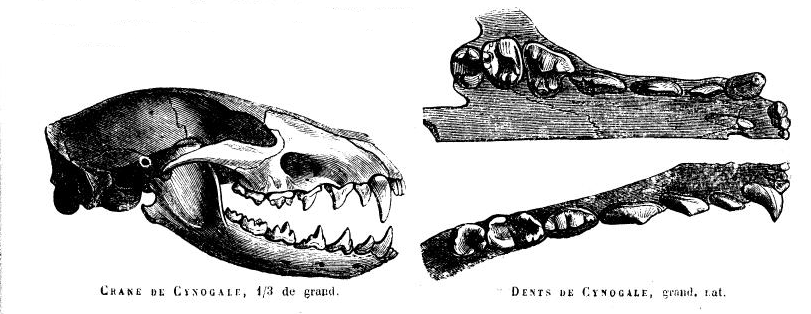|
Viverrid
Viverridae is a family of small to medium-sized, feliform mammals. The viverrids () comprise 33 species placed in 14 genera. This family was named and first described by John Edward Gray in 1821. Viverrids occur all over Africa, southern Europe, and South and Southeast Asia, across the Wallace Line. Their occurrence in Sulawesi and in some of the adjoining islands shows them to be ancient inhabitants of the Old World tropics. Characteristics Viverrids have four or five toes on each foot and half-retractile claws. They have six incisors in each jaw and molars with two tubercular grinders behind in the upper jaw, and one in the lower jaw. The tongue is rough with sharp prickles. A pouch or gland occurs beneath the anus, but there is no cecum. Viverrids are the most primitive of all the families of feliform Carnivora and clearly less specialized than the Felidae. In external characteristics, they are distinguished from the Felidae by the longer muzzle and tuft of facial vibrissae ... [...More Info...] [...Related Items...] OR: [Wikipedia] [Google] [Baidu] |
Feliform
Feliformia is a suborder within the order Carnivora consisting of "cat-like" carnivorans, including cats (large and small), hyenas, mongooses, viverrids, and related taxa. Feliformia stands in contrast to the other suborder of Carnivora, Caniformia (also Canoidea, "dog-like" carnivorans). The separation of the Carnivora into the broad groups of feliforms and caniforms is widely accepted, as is the definition of Feliformia and Caniformia as suborders (sometimes superfamilies). The classification of feliforms as part of the Feliformia suborder or under separate groupings continues to evolve. Systematic classifications dealing with only extant taxa include all feliforms into the Feliformia suborder, though variations exist in the definition and grouping of families and genera.Taxonomic references - extant species (1): Supporting descriptive information and picturesDiversity Web (online) – Feliformia/ref>Taxonomic references - extant species (2)Integrated Taxonomic Information Syst ... [...More Info...] [...Related Items...] OR: [Wikipedia] [Google] [Baidu] |
Diplogale
Hose's palm civet (''Diplogale hosei''), also known as Hose's civet, is a viverrid species endemic to the island of Borneo. It is listed on the IUCN Red List as Vulnerable because of an ongoing population decline, estimated to be more than 30% over the last three generations (inferred to be 15 years) and suspected to be more than 30% in the next three generations due to declines in population inferred from habitat destruction and degradation. ''Diplogale'' is a monospecific genus. Hose's palm civet was named after the zoologist Charles Hose by Oldfield Thomas in 1892. Hose collected the first specimen in Sarawak in 1891. What little is known of the species comes primarily from 17 museum specimens worldwide. Only in 1997, the first living specimen was obtained and released after two months. Hose's civet is not kept in captivity anywhere in the world. Characteristics The upperparts (from nose to tail tip, including outer surfaces of the four limbs) are dark brown to blackish brow ... [...More Info...] [...Related Items...] OR: [Wikipedia] [Google] [Baidu] |
Binturong
The binturong (''Arctictis binturong'') (, ), also known as the bearcat, is a viverrid native to South and Southeast Asia. It is uncommon in much of its range, and has been assessed as Vulnerable on the IUCN Red List because of a declining population trend that is estimated at more than 30% since the mid-1980s. The binturong is the only living species in the genus ''Arctictis''. Etymology The name ''Arctictis'' means 'bear-weasel', from Greek '' arkt-'' 'bear' + '' iktis'' 'weasel'. In Riau, Indonesia it is called 'benturong' and 'tenturun'. Its common name in Borneo is "binturong", which is related to the Western Malayo-Polynesian root "ma-tuRun". Taxonomy ''Viverra binturong'' was the scientific name proposed by Thomas Stamford Raffles in 1822 for a specimen from Malacca. The generic name ''Arctictis'' was proposed by Coenraad Jacob Temminck in 1824. ''Arctictis'' is a monotypic taxon; its morphology is similar to that of members of the genera ''Paradoxurus'' and ''Paguma'' ... [...More Info...] [...Related Items...] OR: [Wikipedia] [Google] [Baidu] |
Arctictis
The binturong (''Arctictis binturong'') (, ), also known as the bearcat, is a viverrid native to South and Southeast Asia. It is uncommon in much of its range, and has been assessed as Vulnerable on the IUCN Red List because of a declining population trend that is estimated at more than 30% since the mid-1980s. The binturong is the only living species in the genus ''Arctictis''. Etymology The name ''Arctictis'' means 'bear-weasel', from Greek '' arkt-'' 'bear' + '' iktis'' 'weasel'. In Riau, Indonesia it is called 'benturong' and 'tenturun'. Its common name in Borneo is "binturong", which is related to the Western Malayo-Polynesian root "ma-tuRun". Taxonomy ''Viverra binturong'' was the scientific name proposed by Thomas Stamford Raffles in 1822 for a specimen from Malacca. The generic name ''Arctictis'' was proposed by Coenraad Jacob Temminck in 1824. ''Arctictis'' is a monotypic taxon; its morphology is similar to that of members of the genera ''Paradoxurus'' and ''Paguma'' ... [...More Info...] [...Related Items...] OR: [Wikipedia] [Google] [Baidu] |
Hemigalus
The banded palm civet (''Hemigalus derbyanus''), also called banded civet, is a viverrid native to Myanmar, Peninsular Malaysia, peninsular Thailand and the Sunda Islands of Sipura, Sumatra and Borneo. It is listed as Near Threatened on the IUCN Red List because of its large geographic and elevation range and tolerance to some habitat disturbance. ''Hemigalus'' is a monospecific genus that was first named and described by Claude Jourdan in 1837. Characteristics The banded palm civet has a long pointed face, reminiscent of insectivorous mammals. It has a long body set on short legs, and five toes on each foot with retractable claws. It looks very similar to Owston's palm civet (''Chrotogale owstoni''), except that it lacks spots on its body, and the hair on its neck points upwards instead of down along the neck. It is also similar to the rare Hose's palm civet (''Diplogale hosei''), an endemic of northern Borneo - they only differ in shape of muzzle and teeth and Hose's civet do ... [...More Info...] [...Related Items...] OR: [Wikipedia] [Google] [Baidu] |
Civettictis
''Civettictis'' is a genus of viverrid that contains the extant African civet ''(Civettictis civetta)'' and a recently described extinct relative from the Plio-Pleistocene of South Africa known as ''Civettictis braini''. Evolution A 2006 phylogenetic study showed that the African civet is closely related to the genus ''Viverra''. It was estimated that the ''Civettictis''-''Viverra'' clade diverged from '' Viverricula'' around 16.2 Mya; the African civet split from ''Viverra'' 12.3 Mya. The authors suggested that the subfamily In biological classification, a subfamily (Latin: ', plural ') is an auxiliary (intermediate) taxonomic rank, next below family but more inclusive than genus. Standard nomenclature rules end subfamily botanical names with "-oideae", and zoologi ... Viverrinae should be bifurcated into Genettinae ('' Poiana'' and '' Genetta'') and Viverrinae (''Civettictis'', ''Viverra'' and '' Viverricula''). The following cladogram is based on this study. References ... [...More Info...] [...Related Items...] OR: [Wikipedia] [Google] [Baidu] |
Viverra
''Viverra'' is a mammalian genus that was first nominated and described by Carl Linnaeus in 1758 as comprising several species including the large Indian civet (''V. zibetha''). The genus was subordinated to the viverrid family by John Edward Gray in 1821. Characteristics ''Viverra'' species are distinguished externally from the other genera of the Viverrinae by the structure of the fore feet: the third and fourth digits have lobes of skin, which act as protective sheaths for the retractile claws. The pads of the feet are surrounded by hair. They have a long and narrow skull, with narrow, nearly parallel-sided, not strongly constricted waist. Their postorbital processes are small and a little in front of the middle point between the tip of the premaxillae in front and of the occipital crest behind. The sagittal crest is moderately strong in adults. The sub-orbital portion of the cheek is comparatively short. The suture between the anterior bone of the zygomatic arch and the maxil ... [...More Info...] [...Related Items...] OR: [Wikipedia] [Google] [Baidu] |
Poiana (genus)
The African linsangs also known as oyans are two species classified in the mammalian subfamily Viverrinae, in the family Viverridae. There is one genus, ''Poiana''. The name ''linsang'' is from Javanese ''linsang'' or ''wlinsang'', which used to be wrongly translated as "otter" in English dictionaries. Linsangs are nocturnal, generally solitary tree dwellers. They are carnivorous, eating squirrels and other rodents, small birds, lizards and insects. Typical size is a little over 30 cm (1 foot), with a tail that more than doubles that length. Bodies are long, with short legs, giving a low appearance. Both species have yellowish bodies with black markings (stripes, blotches and spots), though the distribution and nature of the markings varies between the two species. Taxonomy The genus ''Poiana'' was erected by John Edward Gray in a paper read at the 8 November 1864 meeting of the Zoological Society of London and published the following year, in the ''Proceedings of the Zool ... [...More Info...] [...Related Items...] OR: [Wikipedia] [Google] [Baidu] |
Semigenetta
''Semigenetta'' is an extinct genus of viverrid. It lived in Europe, China and Thailand in the Miocene, and was very similar to the extant genus '' Genetta'', but lacked a molar that ''Genetta'' still possesses. References Viverrids Miocene feliforms Prehistoric carnivoran genera {{paleo-carnivora-stub ... [...More Info...] [...Related Items...] OR: [Wikipedia] [Google] [Baidu] |
Cynogale
The otter civet (''Cynogale bennettii'') is a semiaquatic viverrid native to Thailand, Malaysia, Indonesia and Brunei. It is listed as Endangered because of a serious ongoing population decline, estimated to be more than 50% over the past three generations (estimated to be 15 years), inferred from direct habitat destruction, and indirect inferred declines due to pollutants. ''Cynogale'' is a monospecific genus. Characteristics The otter civet possesses several adaptations to its habitat, including a broad mouth and webbed feet with naked soles and long claws. Its muzzle is long with numerous long whiskers. It is in many ways similar to the Hose's palm civet (''Diplogale hosei'') but has a shorter tail and no whitish underparts. Distribution and habitat Otter civets are distributed in Sumatra, Borneo and peninsular Thailand. Preferred habitat appears to be lowland primary forest, but they have also been recorded in secondary forest, bamboo and logged forest. The supposed ori ... [...More Info...] [...Related Items...] OR: [Wikipedia] [Google] [Baidu] |
Viverrinae
The Viverrinae represent the largest subfamily within the Viverridae comprising five genera, which are subdivided into 22 species native to Africa and Southeast Asia. This subfamily was denominated and first described by John Edward Gray in 1864.Gray, J. E. (1864)''A revision of the genera and species of viverrine animals (Viverridae), founded on the collection in the British Museum'' Proceedings of the Zoological Society of London for the year 1864: 502–579. Classification Gray defined the Viverrinae as comprising the genera ''Proteles'', ''Viverra'', ''Bassaris'' and '' Viverricula''. He subordinated the genera '' Genetta'' and ''Fossa'' to the Genettina, the genera ''Prionodon'' and ''Poiana'' to the Prionodontinae. Reginald Innes Pocock suggested that the African genets (''Genetta'') are also most nearly related to the Viverrinae, but should perhaps form a separate subfamily.Pocock, R. I. (1939)''The fauna of British India, including Ceylon and Burma. Mammalia. – Volum ... [...More Info...] [...Related Items...] OR: [Wikipedia] [Google] [Baidu] |
Kanuites
''Kanuites'' is an extinct genus of paradoxurine viverrid carnivore. It lived in Africa, during the Miocene epoch. Description ''Kanuites'' was about long, and looked remarkably similar to modern genets. ''Kanuites'' was probably an omnivore An omnivore () is an animal that has the ability to eat and survive on both plant and animal matter. Obtaining energy and nutrients from plant and animal matter, omnivores digest carbohydrates, protein, fat, and fiber, and metabolize the nutr ... and may have had retractable claws, like a feline. It may have lived at least part of its life in trees. References Viverrids Miocene carnivorans Miocene mammals of Africa Prehistoric carnivoran genera {{paleo-carnivora-stub ... [...More Info...] [...Related Items...] OR: [Wikipedia] [Google] [Baidu] |







